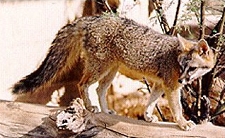Wildlife - Species

Gray Fox (Urocyon cineroargenteus)
Description
The gray fox is smaller than the red fox, standing about 38 cm (15 inches) at the shoulder and weighing 3.2-4.5 kg (7-10 lbs.). Fur color is gray with rust-colored areas under the throat, on the sides of the neck, and on the legs. A black-tipped tail distinguishes the gray fox from the red fox, whose tail has a white tip.
Preferred Habitat and Biology
The gray fox is common throughout much of the United States, with densities in South Carolina being among the highest. The gray fox outnumbers red fox more than three to one, with grays preferring wooded and mixed wooded/open areas. Gray foxes benefit from edge habitats where forest meets field or roadways intersect a forest and are active from dusk to dawn.
Dens may be built in hollow trees or logs, as well as under brush and wooden debris. Gray foxes are monogamous, with mating generally occurring from January to March. Young are born from March to May and the average litter size is 3-5 pups. Like other wild canids, gray fox are susceptible to periodic outbreaks of distemper and weakening by parasites. They can also contract rabies from dogs or other animals. The annual mortality rate is estimated at 52%.
Seldom seen except at night, the gray fox stays within its home range, where it concentrates its activities according to food sources in abundance. The gray fox is an opportunistic omnivore, consuming fruit and berries, corn, acorns, bird eggs, and insects, as well as field mice and rabbits.
The gray fox is capable of climbing and is reported to be the only member of the dog family that can climb. Its main predators are man, dog, bobcat, and great horned owls.
Species Significance
Prized for their fur, gray foxes are primarily taken by trappers. Once they were hunted by houndsmen, but such sport hunting is dwindling due to increased development, danger to hounds from car traffic, and diversion to other game such as deer.
Harvesting actually helps to stabilize the fox population from a "boom and bust" cycle that occurs when numbers increase until starvation and disease depress population density. Current harvests of gray fox in Colleton County remain depressed compared to previous years. Demand for long-fur pelts may eventually increase pressure on this species.
References
Baker, O.E., III and D.B. Carmichael, Jr. 1991. South Carolina's furbearers. South Carolina Department of Natural Resources, Columbia, SC.
Simbeck, R. 1995. For wildlife watchers: Grey fox. South Carolina Wildlife 42(1):48-49.
Webster, W.D., J.F. Parnell, and W.C. Biggs. 1985. Mammals of the Carolinas, Virginia, and Maryland. University of North Carolina Press, Chapel Hill, NC.
